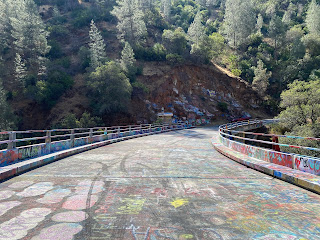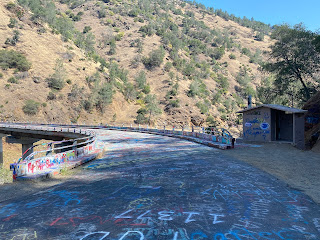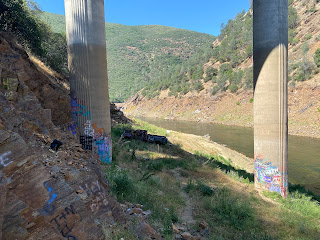Wards Ferry Road is an approximately sixteen-mile-long north/south roadway in the Sierra Nevada Mountains of Tuolumne County. Wards Ferry Road is one of the oldest road corridors in Tuolumne County having been set up as a ferry crossing by Joesph Ward during 1850. Wards Ferry Road was once the primary connecting highway between the communities of Big Oak Flat and Sonora. Wards Ferry Road is most well-known from the largely one-lane wide alignment through Murderer's Gulch where it crosses the Tuolumne River via heavily graffitied 1971 Wards Ferry Bridge. Pictured as the blog cover is the 1897 Wards Ferry Bridge as it was during 1951. The 1897 Wards Ferry Bridge was built upon the anchoring piles of the original 1879 Wards Ferry Bridge which had burned during 1891.
Part 1; the history of Wards Ferry Road
According to Groveland Museum historian Joe Hopkins a ferry crossing across the Tuolumne River across what is now known as Murderer's Gulch was developed by Joseph Ward during 1850. Joseph Ward was ultimately murdered by the highway robbers during 1854 at the site of his ferry at the Tuolumne River. The murder of Joseph Ward would be the inspiration for the name for what is now known as Murderer's Gulch. The highway between Sonora and Big Oak Flat would ultimately assume the name "Wards Ferry Road" from the site of Joseph Ward's ferry. Below a 2019 ABC 10 interview with Joe Hopkins can be viewed:
Below Wards Ferry Road can be seen as the primary highway connecting Sonora and Big Oak Flat on the 1873 Bancroft's Map of California, Nevada, Utah and Arizona.
During 1879 a tolled suspension bridge was constructed in Murderer's Gulch at the site of Wards Ferry. According to Jon Hicks and Ron P. Parker the 1879 Wards Ferry Bridge was burned by bandits January 31st, 1891 to cover the murder toll taker Charles Pease and his friend Byron Lowe. The 1879 Wards Ferry Bridge can be seen in the undated photo below (courtesy Ron P. Parker).
According to Ron P. Parker a truss span was completed utilizing the anchoring piles of the 1879 Wards Ferry Bridge on November 12th, 1897. Below the 1897 Wards Ferry Bridge can be seen along with a wagon crossing the Tuolumne River (courtesy Ron P. Parker).
Wards Ferry Road and the site of the 1897 Wards Ferry Bridge can be seen below on the 1912 United States Geological Survey Map of the Sonora Area.
During 1915 a new pony truss bridge was constructed along Wards Ferry Road at Deer Creek. The 1915 Deer Creek Bridge can be seen below in a University of California Davis sourced photo from 1951.
Wards Ferry Road was largely unaffected by the completion of the first iteration Don Pedro Dam in 1923. The original Don Pedro Reservoir was not large enough to reach the sites of Murderer's Gulch and the 1897 Wards Ferry Bridge. The 1897 Wards Ferry Bridge can be seen during 1951 in a University of California Davis sourced photo.
During 1971 Don Pedro Dam was heighted which led to the catchment area of Don Pedro Reservoir expanding to Murderer's Gulch and the 1897 Wards Ferry Bridge. The 1897 Wards Ferry Bridge truss span was removed which left only the anchoring piles intact. A new Wards Ferry Bridge was constructed downstream which has in modern times come to be known as the "Graffiti Bridge" due to the large amount of vandalism it has been subject to. The site of the 1879 and 1897 Wards Ferry Bridges can be viewed in a photo taken on May 26th, 2022.
Wards Ferry Road can be accessed from California State Route 120 in the community of Big Oak Flat. The area around Big Oak Flat began to be developed after James Savage struck mining claims in the area during 1848. Big Oak Flat was originally known as Savage's Diggins but traditionally has been known by it's modern name. A large sign from California State Route 120 denotes the northbound beginning of Wards Ferry Road.
Wards Ferry Road northbound begins initially as a two-lane roadway before dropping to one lane at Deer Flat Road.
Notably the intersection of Wards Ferry Road and Deer Flat Road was once the site of a small community known as Deer Flat. Deer Flat can be seen on the 1912 United States Geological Survey map.
As Wards Ferry Road northbound approaches Thiel Road traffic is notified of 9 miles of steep one lane roadway ahead in Murderer's Gulch.
Wards Ferry Road northbound narrows and begins run alongside Deer Creek to a small one-lane bridge.
Wards Ferry Road northbound begins to descend towards the Tuolumne River. Wards Ferry Road northbound passes through a narrow switchback before descending to the 1915 Deer Creek Bridge. While descending to the 1915 Deer Creek Bridge via the switchback he lower portions of Wards Ferry Road can be observed. According to pjammcycling.com the average gradient of Wards Ferry Road is 5.5% on average but peaks at 11.7%.
Wards Ferry Road northbound follows the course of Deer Creek into Murderer's Gulch where the Tuolumne River can be observed.
Wards Ferry Road northbound swings towards the 1971 Wards Ferry Bridge upon entering Murderer's Gulch.
As noted in Part 1 the 1971 Wards Ferry Bridge is known by the nickname "Graffiti Bridge." The 1971 Wards Ferry Bridge is subject to heavy amounts of vandalism due to be located in the remote Murderer's Gulch. The 1971 Wards Ferry Bridge is a modern structure with a normal width roadway which stands out as being a strange departure from most of Wards Ferry Road. The views below are facing north on the 1971 Wards Ferry Bridge.
Views on the 1971 Wards Ferry Bridge facing south.
Facing east on the 1971 Wards Ferry Bridge reveals the anchoring piles of the 1879 and 1897 Wards Ferry Bridges.
The anchor points of the 1879/1897 Wards Ferry Bridges can be accessed by way of walking behind the outhouse and climbing down the original abandoned road grade.
Facing east from one of the anchors of the 1879/1897 Wards Ferry Bridge up the Tuolumne River.
Looking west from one of the anchors of the 1879/1897 Ward Ferry Bridge towards the 1971 Bridge.
Several vehicles have been pushed down to the Tuolumne River from the 1971 Wards Ferry Bridge. Below derelict Ford F150 can be seen. Aerial photos reveal what appears to be a red vehicle in the waters of the Tuolumne River beneath the 1971 Wards Ferry Bridge.
Wards Ferry Road northbound from the 1971 Wards Ferry Bridge climbs a series of switchbacks and emerges from Murderer's Gulch at Powell Ranch Road.
Wards Ferry Road north of Powell Ranch Road remains a single lane but has evidence of worn center line striping. Wards Ferry Road northbound approaching Sonora passes by Morgan Chapel and Cemetery, both which were constructed during 1880.
Wards Ferry Road north of Morgan Chapel intersects Old Wards Ferry Road and widens to two-lanes. Old Wards Ferry Road crosses Sullivan Creek and emerges into Sonora at former California State Route 108/Mono Way.
Modern Wards Ferry Road continues north to a terminus at Tuolumne County Route E17/Tuolumne Road.











































































































































































Comments